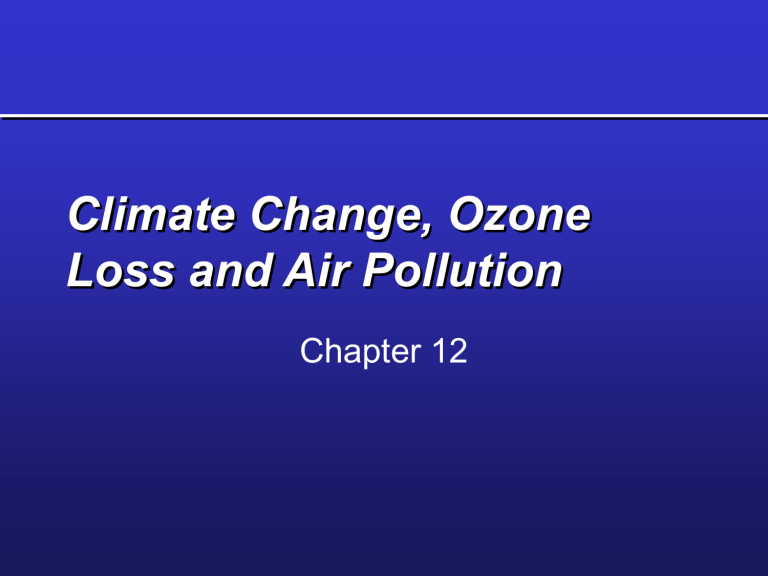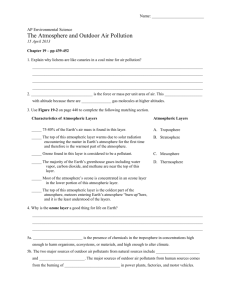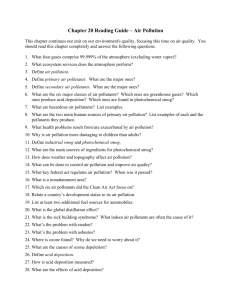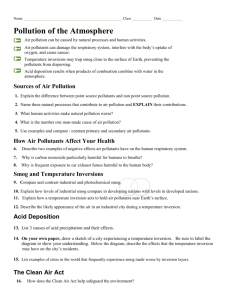Climate Change, Ozone Loss and Air Pollution Chapter 12

Climate Change, Ozone
Loss and Air Pollution
Chapter 12
Key Concepts
• Components of Earth’s atmosphere
• Changes in Earth’s climate over time
• Possible effects of global warming
• Adapting to climate change
• Human impacts on the ozone layer
• Protecting and restoring the ozone layer
Troposphere
• Where weather happens
• Location - surface to about 10 km.
• Composition - unpolluted air: Nitrogen
(78%) Oxygen (21%). Remaining 1% is
CO
2 (0.0365%)
, H, He, Ar.
– Water vapor is an additional variable amount, .01% to 5%.
Stratosphere
• Where jets fly (at the bottom of it)
• Location - Above troposphere, about 10-
50 km. Very thin air - virtually no weather, and no turbulence.
• Composition- Similar to troposphere, except
– water vapor is 1000 x less
– ozone is 1000 x greater.
Climate and Weather
• Climate = long-term atmospheric conditions
• Weather = short-term atmospheric conditions
• Both climate and weather are dynamic – they change with time
The Greenhouse Effect
Greenhouse gases
• Carbon Dioxide - fossil fuel burning, land clearing/burning.
• Methane - Breakdown of organic material by anaerobic bacteria.
• Nitrous Oxide - Biomass burning, automobile exhaust.
• Ozone – automobile exhaust
• Chlorofluorocarbons - Refrigerants, cleaning solvents, propellants.
CO
2 measurements
Evidence for Climate Change
1. 20 th C was hottest in the past 1000 years
2. Global temp has risen 0.6°C (1.1°F) since
1861
3. 16 warmest years on record since 1980, 10 warmest since 1990
4. Glaciers and sea ice are melting
5. Sea level has risen 100-200 cm over 20 th C
Projecting Future Changes in Earth’s
Climate
We can’t do real experiments on the whole earth’s climate, so how do we predict future climate change?
• Scale up from small experiments
• Computer models (GCMs)
• Learn from the past
– Paleoclimatology and Paleoecology
Past Climate Changes
CO
2 and temperature from ice cores
Paleoecology: biological responses to past climate change
Projected future global warming
Biological responses to potential future climate change
Ocean currents “conveyor belt”
Some Possible Effects of a
Warmer World
• See figure
12-10
Solutions: Dealing with the Threat of Climate Change
Options
• Do more research before acting
– “wait and see” (current US strategy)
• Act now to reduce risks because global warming would have severe impacts
• Act now in same way to reduce risks of global warming because it has other benefits to environment and society (even if warming doesn’t happen)
Removing CO
2 from the Atmosphere
Reducing Greenhouse Gas Emissions
• 1988 - Intergovernmental Panel on Climate Change
(IPCC) established, body of scientists advising UN on climate change
• 1997 - Representatives of 161 nations met in
Kyoto, Japan for a UN meeting on climate change
• Kyoto Protocol - agreement reached during meeting to reduce CO
2 emissions from 39 developed countries to 5.2% below 1990 levels by 2012.
• 2001 US pulled out of the agreement.
• Russia’s recent ratification was enough for the
Kyoto Protocol to take effect.
• Will there be a new post-Kyoto treaty?
Ozone in the Stratosphere: the “Ozone hole”
• Ozone (O
3
) in the stratosphere protects life on the surface of the earth from harmful UV solar radiation.
CFCs
• Chlorofluorocarbons (CFCs) and related chemicals break down ozone in stratosphere
• Uses (mostly phased out)
• Air Conditioners
• Refrigerators
• Spray cans
• Cleaners for electronic parts
• Sterilizing medical instruments
• Fumigants for granaries and cargo ships
Ozone Depletion in the Stratosphere
Seasonal Ozone Layer Thinning at the Poles
Credit: © Science VU/NASA/Visuals Unlimited
Large Antarctic Ozone hole three times the size of the United States. September, 2000.
Loss of the Ozone Layer:
Reasons for Concern
• Increased incidence and severity of sunburn
• Increase in eye cataracts
• Increased incidence of skin cancer
• Immune system suppression
• Increase in acid deposition
• Lower crop yields and decline in productivity
Skin Cancers
Solutions: Protecting the Ozone Layer
• CFC substitutes
• Montreal Protocol 1987
• Copenhagen Protocol 1992
• both signed by 177 countries
• CFCs take 10-20 years to get to the stratosphere
• CFCs take 65-385 years to break down
Future CFC concentrations
Air Pollution
Key Concepts
• Structure and composition of the atmosphere
• Types and sources of outdoor air pollution
• Types, formation, and effects of smog
• Sources and effects of acid deposition
• Effects of air pollution
• Prevention and control of air pollution
Outdoor Air Pollution
• Primary - Released directly from planet’s surface. Dust, smoke particles, Nitrogen, Carbon etc.
• Secondary - Formed when primary pollutants react or combine with one another, or basic elements.
Primary Air Pollutants
Carbon Monoxide—Produced when organic materials are incompletely burned.
• Single largest source is the automobile.
• Not a persistent pollutant.
• Binds to hemoglobin in blood and makes the hemoglobin less able to carry oxygen.
• Most dangerous in enclosed spaces.
• Cigarette smoking an important source.
Primary Air Pollutants
Volatile Organic Compounds
• Hydrocarbons - Group of organic compounds consisting of carbon and hydrogen.
– Evaporated from automobile fuel or remnants of fuel incompletely burned.
– Catalytic converters used to burn exhaust gases more completely.
Primary Air Pollutants
Particulates—Minute pieces of solid materials dispersed into the atmosphere
(<10 microns).
• Smoke, Asbestos, Dust, Ash
• Can accumulate in lungs and interfere with the ability of lungs to exchange gases.
Primary Air Pollutants
Sulfur Dioxide (SO produced when sulfur-containing fossil fuels are burned.
2
)—Sulfur and oxygen compound
• Burning coal is primary artificial source
• Volcanoes and hot springs are natural sources
• Mt St Helens releases 50 to 250 tons/day when active
• Steam Plant recently: 200 tons/day
• After scrubbers installed (cost $250 million): 27 tons/day
• SO
2 is also a precursor to acid rain (a secondary pollutant)
Primary Air Pollutants
• Nitrogen Oxides (NO, NO
2
)—Formed when combustion takes place in the air.
– Automobile exhaust is primary source.
– NO x is also a precursor to acid rain and photochemical smog (both secondary pollutants) and is a greenhouse gas
Secondary Air Pollutants
• Ozone (O
3
)
• PANs (Peroxyacetyl nitrate)
• Aldehydes
• all three formed by interaction between
NO x and VOCs.
• Note: - Ozone is a pollutant in the troposphere, but natural and beneficial in the stratosphere.
Photochemical Smog
• Brown-air smog
• Some primary pollutants react under the influence of sunlight
(photochemical reaction), including
NO x
, O
3
, PANs.
Corrosive, irritating.
• Common in urban areas of the west US: cars + sun + mountains.
Los Angeles smog.
Credit: © John D. Cunningham/Visuals Unlimited
213524
Industrial Smog
• Gray-air smog
• From burning coal and oil
(particulates, sulfur dioxide, sulfuric acid).
• London was the smog capitol. In 1952, smog developed for days, no atmospheric mixing, 4,000 people died.
• Now mainly a problem in
LDCs with developing industries and no pollution control laws.
Thermal inversion
• warm air normally near surface, pollutants disperse as air rises and mixes
• when cool air trapped under warm air, confined by mountains, pollutants do not disperse, intensify with time
Regional Outdoor Air Pollution from
Acid Deposition
• Wet deposition • Dry deposition
Acid Deposition in the US
Acid Deposition and Humans
• Respiratory diseases
• Toxic metal leaching
• Damage to structures, especially containing calcium carbonate
• Decreased visibility
• Decreased productivity and profitability of fisheries, forests, and farms
Acid Deposition and Aquatic Systems
• Fish declines
• Aluminum toxicity
• Acid shock
Acid Deposition, Plants, and Soil
• Nutrient leaching
• Heavy metal release
• Weakens trees
Credit: © Rob & Ann Simpson/Visuals Unlimited
Acid rain-damaged Fraser Fir and Red Spruce trees. Mt. Mitchell State Park, North Carolina.
Solutions to Acid Deposition
Indoor Air Pollution
Radon
• Radioactive radon-
222
• Lung cancer threat
• Occurs in certain areas based on geology
• Associated with uranium and organic material in rock
Effects of Air Pollution on People
• Respiratory diseases
• Asthma
• Lung cancer
• Chronic bronchitis
• Emphysema
• Premature death
Clean Air Act
(1967, 1970, 1977, 1990)
• Series of detailed control requirements the federal government implements and states administer.
– All sources subject to ambient air quality regulation.
– New sources subject to more stringent controls.
– Visibility reducing emissions regulated.
• Since passage, EPA reports air pollution cut by
1/3 and acid rain cut by 25%.
• EPA estimates benefits to human and environmental health outweigh costs 40:1.
National Ambient Air Quality Standards
• NAAQS established for six pollutants:
– Sulfur Dioxide
– Nitrogen Oxides
– Particulate Matter
– Carbon Monoxide
– Ozone
– Lead
• Experts say two other important pollutants should be listed:
– Volatile Organic Compounds
– Carbon Dioxide
Control of Air Pollution
• Industrial Activities
– Scrubbers
– Precipitators
– Filters
• Sulfur Removal
– Switch to low-sulfur fuel.
– Remove sulfur from fuel before use.
– Scrubbing gases emitted from smokestack.
So what is in your car’s exhaust?
• CO
• CO
2
• NOx
• VOCs
• PM
• And can lead to formation of secondary pollutants
Emission Reduction
Reducing Motor Vehicle Air
Pollution
Reducing Indoor
Air Pollution





